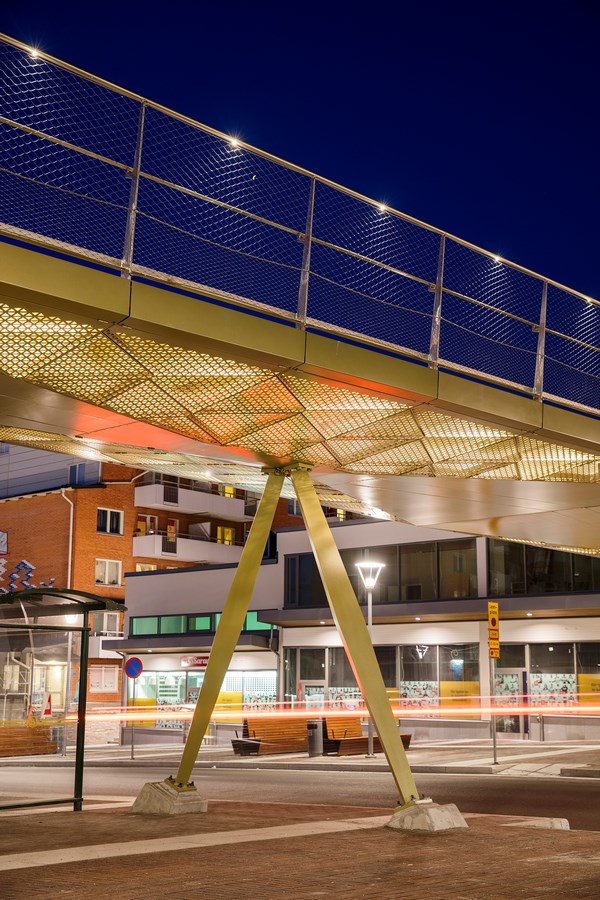The project is a part of a larger strategy aiming to transform a traffic-oriented area into an active and lively environment for pedestrians. The three-span steel bridge displays golden facetted surfaces, resembling an exotic insect with slender legs that has landed with its wings half folded up, ready at any time to take off again. The plan is symmetrical and slightly widened in the middle, inviting passers to stop and take part to the street life below. The bridge is a place – not just a passage.
Project name: Bridge in Rinkeby
Location: Rinkeby, Stockholm
Completion date: 30/5 2016
Dimensions: Length 32,3 m Witdth 3,5-5,5 metres Tonnage: 32,2 ton
Structural concept: Steel beam bridge in three spans
LOCATION
The bridge for bicycles and pedestrians over Rinkebystråket is located in Rinkeby, a northern suburb of Stockholm. It is a part of a larger project aiming to transform a traffic-oriented area into an active and lively environment for pedestrians, with shops and public spaces along the street.


FUNCTION
The Northern Square, where the bridge crosses, is an important place that connects both with regional motorways, as well as between the two levels. The bridge is, beyond being a convenient passage over the street, also enhancing the interaction between the different levels while opening views of the distant landscape.

THE DESIGN AND CONSTRUCTION
The bridge has become an important part of the local public space and stands out in contrast to other bridges over Rinkebystråket. We aimed to design it as a place – not just a passage separated from the lower level.
The bridge is a golden slender steel beam bridge, in three spans, with a total length of 32,3 meters. The main span is 13,2 meters and the shorter side spans are 9,5 meters.
The shape is simple, the plan is symmetrical and slightly widened in the middle, and then it tapers off at the abutments. The little widening shape invite passers to stop and look out over the lively road below. The abutments are integrated in the surrounded buildings and revealing how the bridge has been adjusted to fit in between the blocks.

The architecture of the bridge is an expression of the structural system. The supporting beam consists of a steel box with variable width and height which forms a sequence of triangular volumes. The underside of the deck is broken into several triangular surfaces, reflecting the shape of the beam. Where the beam is dense, the sides of the beam are cladded with triangular sheets perforated in a triangular pattern. The perforated sheets are illuminated from the inside, to create a warm lamp-like gleaming at the square on the lower level. The perforated sheets can be opened to enable service of the light armatures.

The rail of untreated stainless steel consists of slender posts and stainless-steel nets of varied densities, but with high transparency, allowing good visibility between the levels. The rail is rounded, with integrated led fixtures, casting light on the bridge deck and the railing. The triangulated pattern of the structure reappears on the yellow acrylic coating of the deck.

MATERIAL AND PRODUCTION
The main steel beam is made of golden painted steel. The perforated plates on the underside are of stainless steel painted in the same golden colour, as the rest of the bridge. The rails stand out as untreated stainless steel. The whole bridge was produced in Poland by Vistal and lifted in place in one piece. The net rails, the pillars, and the perforated plates were mounted on site.
&Rundquist is an architectural office started in 1993 under the name of Henrik Rundquist Arkitektkontor AB and run during the period 1999 to 2008 under the name KHR Rundquist arkitekter ab, then co-owned by KHR Architects AS in Copenhagen.
The office is located in Södermalm, in central Stockholm, Sweden, and has around thirty architects often working in collaboration with landscape architects, engineers, real estate developers and other specialists. Their projects range from the design of urban environments all the way to the architecture of buildings and facilities like terminals, stations, bridges and focuses on achieving high-quality of the public realm.
Whilst the demands on technology and function are often dominant in their assignments, &Rundquist uses them as a tool to generate unique architectural qualities. Many commissions are the result of first prizes won in competitions and parallel assignments and the office has been awarded with both the Kasper Salin Prize for the Arlanda Pier F, and the European Steel Design Award for the Floating Roof in Vällingby Centre and the Sundsvall Bridge. Their clients are mainly government agencies, municipalities and publicly owned companies, and the office works through
all stages of municipal planning, road and rail planning, all the way to specification and construction documents. From large-scale questions, dealing with neighborhoods and complex buildings, down to the detailed design of urban furniture – they handle all aspects of the public space.
&Rundquist stands for the close collaboration – with clients, with partners, and not least within project teams.





